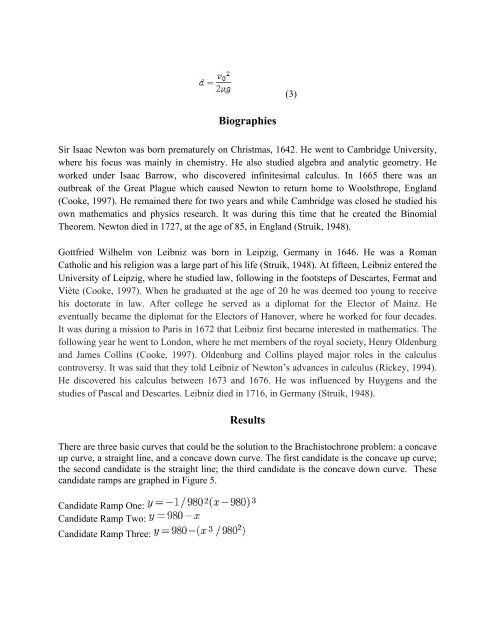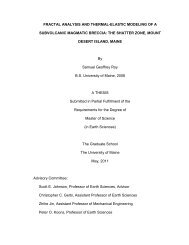Exploring the Methods of Differential Calculus through the ...
Exploring the Methods of Differential Calculus through the ...
Exploring the Methods of Differential Calculus through the ...
You also want an ePaper? Increase the reach of your titles
YUMPU automatically turns print PDFs into web optimized ePapers that Google loves.
Biographies<br />
Sir Isaac Newton was born prematurely on Christmas, 1642. He went to Cambridge University,<br />
where his focus was mainly in chemistry. He also studied algebra and analytic geometry. He<br />
worked under Isaac Barrow, who discovered infinitesimal calculus. In 1665 <strong>the</strong>re was an<br />
outbreak <strong>of</strong> <strong>the</strong> Great Plague which caused Newton to return home to Woolsthrope, England<br />
(Cooke, 1997). He remained <strong>the</strong>re for two years and while Cambridge was closed he studied his<br />
own ma<strong>the</strong>matics and physics research. It was during this time that he created <strong>the</strong> Binomial<br />
Theorem. Newton died in 1727, at <strong>the</strong> age <strong>of</strong> 85, in England (Struik, 1948).<br />
Gottfried Wilhelm von Leibniz was born in Leipzig, Germany in 1646. He was a Roman<br />
Catholic and his religion was a large part <strong>of</strong> his life (Struik, 1948). At fifteen, Leibniz entered <strong>the</strong><br />
University <strong>of</strong> Leipzig, where he studied law, following in <strong>the</strong> footsteps <strong>of</strong> Descartes, Fermat and<br />
Viète (Cooke, 1997). When he graduated at <strong>the</strong> age <strong>of</strong> 20 he was deemed too young to receive<br />
his doctorate in law. After college he served as a diplomat for <strong>the</strong> Elector <strong>of</strong> Mainz. He<br />
eventually became <strong>the</strong> diplomat for <strong>the</strong> Electors <strong>of</strong> Hanover, where he worked for four decades.<br />
It was during a mission to Paris in 1672 that Leibniz first became interested in ma<strong>the</strong>matics. The<br />
following year he went to London, where he met members <strong>of</strong> <strong>the</strong> royal society, Henry Oldenburg<br />
and James Collins (Cooke, 1997). Oldenburg and Collins played major roles in <strong>the</strong> calculus<br />
controversy. It was said that <strong>the</strong>y told Leibniz <strong>of</strong> Newton’s advances in calculus (Rickey, 1994).<br />
He discovered his calculus between 1673 and 1676. He was influenced by Huygens and <strong>the</strong><br />
studies <strong>of</strong> Pascal and Descartes. Leibniz died in 1716, in Germany (Struik, 1948).<br />
Results<br />
There are three basic curves that could be <strong>the</strong> solution to <strong>the</strong> Brachistochrone problem: a concave<br />
up curve, a straight line, and a concave down curve. The first candidate is <strong>the</strong> concave up curve;<br />
<strong>the</strong> second candidate is <strong>the</strong> straight line; <strong>the</strong> third candidate is <strong>the</strong> concave down curve. These<br />
candidate ramps are graphed in Figure 5.<br />
Candidate Ramp One:<br />
Candidate Ramp Two:<br />
Candidate Ramp Three:<br />
(3)
















